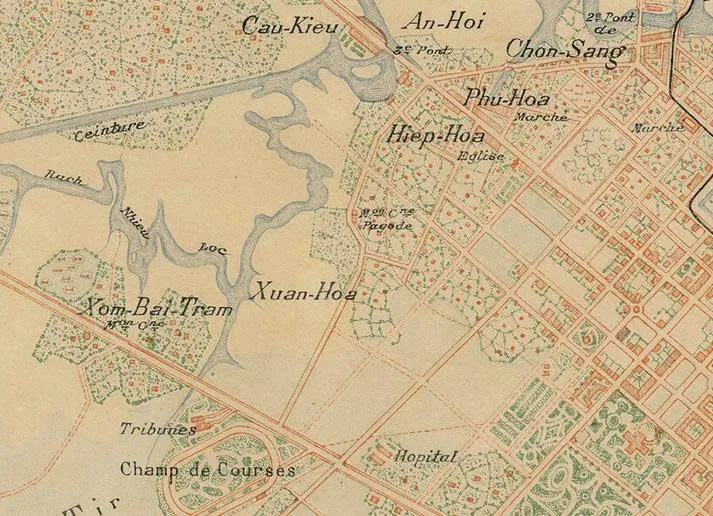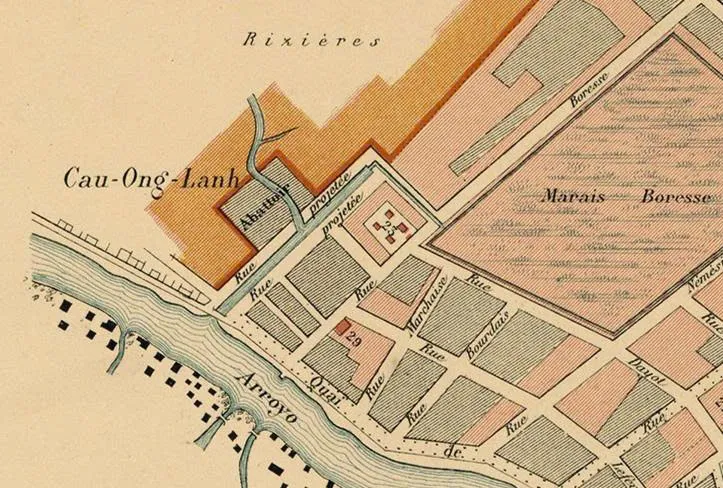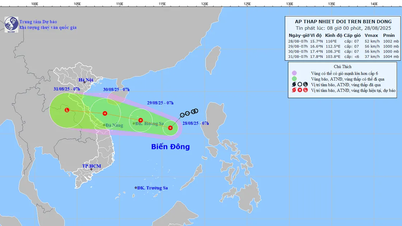This is confirmed in the historical novel Nam Trieu Cong Nghiep Dien Chi (also known as Viet Nam Khai Quoc Chi Truyen) by Nguyen Khoa Chiem (1659-1736), it can be said that the author was the earliest contemporary to record the name of Saigon.
1. When Commander Nguyen Huu Canh came to Dong Nai and Saigon to establish an administrative system in 1698, the Saigon area was named Gia Dinh prefecture. This prefecture only had one district, Tan Binh. The core area of the prefecture was the administrative agency Phien Tran palace.
From this time, Saigon became a name representing a region, but not the name on administrative documents; and from the time of Lord Nguyen until the end of the Nguyen Dynasty, the administrative structure in Saigon changed many times (prefecture, town, citadel, palace, province), but in the end, the name Gia Dinh was still kept. The two names Saigon and Gia Dinh, one is an ancient land name (region) and the other is an old administrative name, so it is deeply ingrained in the subconscious of the local people.

When the French established the administrative system in the land of the six provinces of Cochinchina (1862-1867), they changed many place names from beautiful characters (Chinese characters) to names of regions (Nom characters). Beautiful character place names were favored by the Nguyen Dynasty, such as Saigon named Gia Dinh, Dong Nai named Bien Hoa, Ba Ria - Mo Xoai named Phuoc An district, My Tho named Dinh Tuong,...; and the system of administrative place names at the provincial, prefectural, district, and village (commune, ward) levels mostly used beautiful characters.
The French were influenced by the Nom system of place names for parishes/dioceses recorded by missionaries since the 17th century, so they changed the way of naming administrative places established by the Nguyen Dynasty, using many Nom names transcribed into the Latin national language to name administrative places, a series of counties, provinces, and cities used Nom names such as Saigon, Cho Lon, Ba Ria, Thu Dau Mot, My Tho, Go Cong, Sa Dec, Mo Cay...; the way of calling administrative places with Nom names coincidentally matched the familiar folk names from the past, which were familiar names of places that the immigrants themselves named in the new land.
2. The history of administrative place names in a large area like Ho Chi Minh City today would take up countless pages and ink. First, we can take a quick look at the core of old Saigon - Gia Dinh through the names of some new wards.
Saigon Ward, Ben Thanh Ward, the center, retains its original folk name from the name of the place and the name of the river wharf, which have been continuously recorded in historical records. Previously, in the academic world, there were some opinions that seemed to disagree on how to name a ward Saigon, saying that the geographical scale was not appropriate. Those opinions may have been based on sentimental considerations and not based on the source of historical flow.
In the early days, the name Saigon was just a small place that could be equivalent to an administrative village, like Ben Thanh which originally meant the location of a wharf in front of the citadel (Gia Dinh), because they were places of trade so they easily spread and were used as a representative name for a larger area of land; and during the Nguyen Dynasty, Saigon was never given to any administrative unit.
Today, Saigon Ward has restored its old name within its old geographical area, in accordance with ancient folk traditions, and also different from the way the French used to call a large city. It should also be added that the entire long river from the upstream of Dau Tieng to the Nha Be junction was also named "Sai Gon River" by the French on the map since 1858, while the Nguyen Dynasty's historical records recorded this river with many names corresponding to each section of the river.
Xuan Hoa Ward restored the place name of the village established during the Tu Duc period, separated from Tan Dinh village (established during the Gia Long period), belonging to Binh Tri Thuong commune. This village name was kept until the beginning of the French period, and the village was changed to a village. Xuan Hoa village belonged to Saigon district, until 1895 it was dissolved and lost its name, the village land partly belonged to the inner city of Saigon at that time and partly merged into Hoa Hung village.
Thus, Xuan Hoa is the administrative name of the village that existed from 1850 to 1895, then disappeared for 130 years without being mentioned, and is now being used again. Fortunately, there is still the Xuan Hoa communal house built by the villagers in the past that still exists today, if it were not for this communal house, probably not many people would remember the place name Xuan Hoa.
Nhieu Loc Ward, a place name originally the name of a canal, in the Southern Six Provinces Geography by Duy Minh Thi printed in 1872, in the Gia Dinh province section, in the Binh Tri River (Thi Nghe canal) section, it was written: "Hue Bridge (惠橋), commonly called Nhieu Loc Bridge (橋饒祿)". That is, Hue Bridge is commonly called Nhieu Loc Bridge, which can be understood as the bridge spanning Nhieu Loc canal.
As for Hue Kieu (Hue Bridge), many old sources from the early 19th century such as Hoang Viet Nhat Thong Du Dia Chi (1806), Tran Van Hoc map (1815) and Gia Dinh Thanh Thong Chi (1820) all mentioned it with the name Lao Hue Bridge. Nhieu Loc Canal, looking at the 1895 Saigon map, we see a V-shaped flow, in the South and at both mouths, it flows into Thi Nghe Canal, this canal has now been filled in, the name Nhieu Loc Canal, which is straight today, is actually the head of Thi Nghe Canal in the past. Using geographical place names to name administrative units has the advantage of being consistent with the familiar way of calling of the people.
Also from the familiar way of calling, we can see the way of naming from local characters such as Mr. Nhieu (a degree lower than bachelor's degree) named Loc or something among the common people, as well as Mr. To, Lao Hue, Mr. Buong, Mr. Ta..., who contributed to the land, the proper name was called by later people to show gratitude.
In the case of Cau Ong Lanh (ward name), although Mr. Truong Vinh Ky said "the wooden bridge was built by Mr. Lanh, a soldier living nearby" (1885), many articles on the internet claim that this bridge crosses Ben Nghe canal, connecting District 1 with District 4 (old), and that Mr. Lanh is also known as Lanh Binh Thang, both of which have no authentic historical data.
Ong Lanh Bridge crosses Ong Lanh Canal, the mouth of this canal flows into Ben Nghe Canal, the tip of the canal goes north to the Slaughterhouse area, where the 1878 French map recorded as "Abattoir", meaning Ong Lanh Bridge parallel to Ben Nghe Canal; only with Ong Lanh Canal, there is Ong Lanh Bridge, people gather to buy and sell near the bridge, which is called "Cau Ong Lanh Hamlet" and "Cau Ong Lanh Market", the evolution of this place name over a long period of time, so assigning it to Ong Lanh, aka Lanh Binh Thang during the anti-French period, seems unconvincing, it is necessary to study historical sources more carefully.

Tan Dinh Ward has retained its very old administrative name at the village level in Saigon. During the Gia Long period, in 1808, Tan Dinh was a hamlet (equivalent to a hamlet), meaning the population was only a few dozen people with ten houses. The Tran Van Hoc map (1815) recorded it as "Tan Dinh mound" and did not show a residential area. When establishing the Gia Dinh province land register (1836), it was upgraded to a village. Tan Dinh village went through several separations during the French period and then lost its administrative name. It was not until 1988 that Tan Dinh was restored as a ward name, and now its area is larger.
3. In a new look, the core of Ho Chi Minh City now uses administrative ward names that have enough characteristics of the long-standing flow on Saigon land in terms of toponymy.
Although the number of wards has decreased, the old canal names (Nhieu Loc) and hamlet names (Cau Ong Lanh) are still preserved, which are familiar folk names. The name of Tan Dinh hamlet in the early days of Saigon is still preserved, and the name of Xuan Hoa village, which only has the vestige of a communal house, are administrative titles expressing the desire for peace.
And the two place names of Saigon and Gia Dinh province, which have been famous and established for hundreds of years and are deeply ingrained in the memories of not only the people here but also the people of the six provinces and the people from all over the country, are now properly recorded in administrative documents.
Source: https://www.sggp.org.vn/tu-xu-sai-gon-xua-den-tphcm-ngay-nay-post802638.html







![[Photo] Images of the State-level preliminary rehearsal of the military parade at Ba Dinh Square](https://vphoto.vietnam.vn/thumb/1200x675/vietnam/resource/IMAGE/2025/8/27/807e4479c81f408ca16b916ba381b667)































![[Photo] Parade blocks pass through Hang Khay-Trang Tien during the preliminary rehearsal](https://vphoto.vietnam.vn/thumb/1200x675/vietnam/resource/IMAGE/2025/8/27/456962fff72d40269327ac1d01426969)






























































Comment (0)